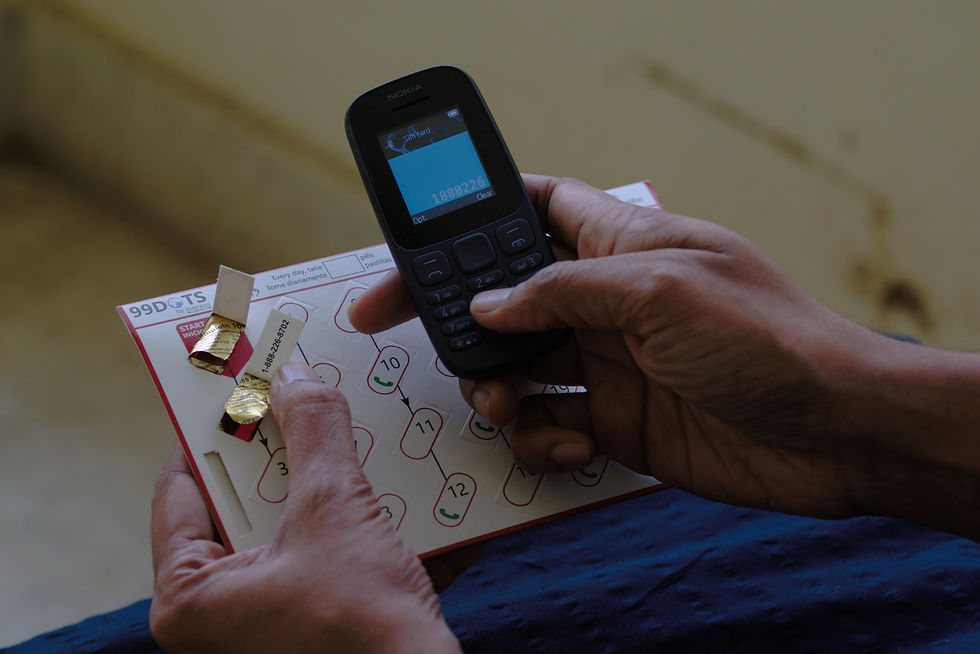Co-creating solutions to combat TB
- Everwell Team
- Dec 2, 2019
- 4 min read
Updated: Mar 26, 2021

Siddhalingamma works in a garment factory in Bangalore and was diagnosed with TB. She was put on a daily regime TB medication course for 6 months, which was provided free of cost under the public healthcare program. She fought a tough battle - ultimately, she emerged healthy and completely cured of TB.
Before we get to know more on how she won this battle, let us go back in time a few years, though not very far :)
Prior to the start of the daily regime of anti-Tuberculosis medication, the TB public program under the Revised National Tuberculosis Program (RNTCP) of Central TB Division (CTD) followed the traditional implementation of DOTS (Directly Observed Treatment Short Course). DOTS was designed to ensure high adherence by patients by requiring them to take medicines in the physical presence of a provider/health care worker.
In a typical course of treatment, that meant a patient had to travel to a DOTS center three times a week for the first two months known as the Intensive Phase, and at least once a week for another four months known as the Continuation Phase. Courses could also be extended beyond 6 months, and enforcement of DOTS was a major challenge for many.
Just imagine if Siddhalingamma was put on the intermittent regime. She would have to take permission from her garment factory supervisor to take time off (at least half a day) three times a week for at least two months. They might agree to allow her time off, but not without negotiating on her daily wage. Additionally, she has to pay for the travel cost, and all the while she is not in her best health to travel so often.
Luckily, she did not have to go through all this pain. Why?
Thanks to the introduction of Daily Regime with Fixed Dose Combination, Siddhalingamma did not have to travel daily to a DOTS centre. Instead, Siddhalingamma can take one-months’ worth medication at a time with her from the centre and take the medicines daily on her own. With the new regimen, she came only once a month to get her refills and also meet the health care staff to check how she is progressing in her treatment.
She was very happy with this arrangement. The only major concern the health care staff had was how to support Siddhalingamma's adherence to her medication in between refills. They cannot visit her daily to check if she has taken the medicines or not. It was not a matter of trust, but because the healthcare workers care for her recovery, and the challenges in recovery from TB can be much larger than simply taking the medication. With the daily regime, this was a concern for the programme as a whole.
The solution to this was found by the introduction of 99DOTS – a low cost ICT enabled platform to remotely monitor adherence through a phone call (https://www.99dots.org/). This solution was co-created by a joint effort between several organizations and entities supporting innovations to end TB: private entities like Microsoft Research and Everwell, international funders, implementing partners, and the Government of India's RNTCP program.

Siddhalingamma was given her medication wrapped in a special 99DOTS envelope. Every day, she dispensed the daily dose pills from the perforated pill flap. After consuming the pills, she made a toll-free call to the hidden toll-free number revealed behind the flap. Note that these are random numbers and do not repeat the next day. Also, the patient sees the number only after the pill is in hand. So, it guarantees pill-in-hand adherence. Patients only need daily access to a basic mobile phone, even if it is shared among users.

As soon as she makes a free call to this number, the 99DOTS system marks the patient as adherent for the day. It can be seen by health care providers in a digital calendar with a green box for the day. On any day, if she forgot to take medicine and make the free call in the morning when doctors prescribe patients to take their pills, she would get a reminder. If by the afternoon, the system still had not heard from her, her dedicated health care staff would get an SMS triggering an alert that Siddhalingamma might have forgotten to take her medication. Staff would call her immediately and remind her to take medication. The goal was not to burden or strictly monitor the patient with consequences, but rather to empower patients to take their medication independent of physical observation, while maintaining an active channel for engagement and outreach with healthcare workers.
Siddhalingamma says that this was the best part she loved. She was happy whenever the health worker would call to remind her to take medication. She was happy that apart from her family members, there were others too who wanted her speedy recovery.
WATCH SIDDHALINGAMMA SPEAK ABOUT HER TB TREATMENT EXPERIENCE:
In this video, you can hear what Manjesh has to say about his experience with 99DOTS. Manjesh is a dedicated health care provider who views 99DOTS adherence daily to monitor his patients. Before 99DOTS he relied on paper records.
Today, Siddhalingamma is completely cured of TB and continues to go to work. She wants to be an inspiration to other TB patients. Kudos to her, healthcare staff like Manjesh who took care of her till her recovery, and the thousands of patients and staff dedicated to eradicating TB in India. While there are always ways to improve healthcare delivery and access for patients, this is a great example of how the Government of India, Grant Funders, Private Organizations, Policy Makers, and Technology Enablers can come together to co-create solutions and help in eliminating TB.
Comments